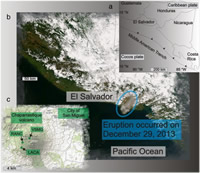The 2013 eruption of Chaparrastique volcano (El Salvador): Effects of magma storage, mixing, and decompression
Scarlato P., S. Mollo, E. Del Bello, A. von Quadt, R.J. Brown, E. Gutierrez, B. Martinez-Hackert, P. Papale (2017)
Chemical Geology, 448, 110-122, https://doi.org/10.1016/j.chemgeo.2016.11.015.
Abstract
On December 29, 2013, an isolated vulcanian-type eruption occurred at Chaparrastique volcano (El Salvador) after 12 years of inactivity. The eruption was classified as VEI 2 and produced an ash plume with a maximum height of ~ 9 km. Textural and compositional data from phenocrysts from the erupted products have been integrated with geochemical and isotopic information from bulk rocks to elucidate the magmatic processes responsible for the reawakening of volcanic activity.
Phenocrysts consist of Fo-rich poikilitic olivines hosting high-Mg titanomagnetites, and Fo-poor olivines coexisting with low-Mg titanomagnetites. Mineral-melt equilibria suggest an origin for the distinct phenocryst populations by mixing between a high-T (~ 1130–1150 °C), basaltic magma with fO2 (NNO buffer) typical of the lower crust in arc systems and a low-T (~ 1060–1080 °C), basaltic andesitic magma with fO2 (NNO + 1 buffer) commonly encountered in shallower, more oxidized crustal reservoirs. Thermobarometry based on Fe-Mg exchange between orthopyroxene and clinopyroxene constrains the crystallization before eruption at relative low-P (~ 150–250 MPa) and low-T (~ 1000–1050 °C). Mixing between two chemically distinct magmas is also evidenced by the occurrence of reverse zoned plagioclase phenocrysts with resorbed sodic cores and re-growth of sieve-textured calcic mantles. Conversely, plagioclase rims exhibit disequilibrium compositions addressed to decompression kinetics (~ 10− 3 MPa/s) driven by rapid magma ascent to the surface (~ 0.03 m/s).
Major and trace element modelling excludes fractional crystallization as the primary mechanism controlling the bulk rock variability, whereas geochemical data align along a mixing trend between two end-members representative of the primitive basalt and the differentiated basaltic andesite. Trace element and isotope data indicate that the primary source of magmatism is an enriched MORB-like mantle with the contribution of fluxes of metasomatic fluids and/or melts produced by the subducted slab. The role played by slab-fluid inputs of carbonate origin and slab-melts from the hemipelagic sediments seems to be minimal. Assimilation/contamination processes of magmas by crustal rocks are also negligible. In contrast, the geochemical signature of magmas is greatly influenced by slab-derived aqueous fluids produced prevalently by progressive dehydration of marine sediments and altered basaltic crust.
https://www.sciencedirect.com/science/article/pii/S0009254116306179


